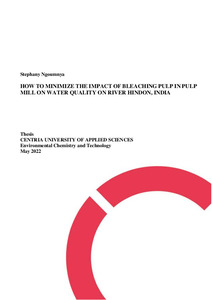How to minimize the impact of bleaching pulp in pulp mill on water quality on river Hindon, India
Nkwonji, Stephany Ngoumnya (2022)
Nkwonji, Stephany Ngoumnya
2022
All rights reserved. This publication is copyrighted. You may download, display and print it for Your own personal use. Commercial use is prohibited.
Julkaisun pysyvä osoite on
https://urn.fi/URN:NBN:fi:amk-2022052512001
https://urn.fi/URN:NBN:fi:amk-2022052512001
Tiivistelmä
As a result of the increasing demand of paper in India, pulp mills are constantly in production. Pulp is a lignocellulosic fibrous material that is made from separating cellulose fibres from wood matrix chemically and mechanically. Chemical pulping process depends on chemicals effects to separate fibres from wood, while mechanical pulping process entirely depends on physical activity. Both processes aim at removing residual lignin in pulp. Pulp cannot be used in paper production without bleaching because of its brightness. Bleaching pulp is the chemical treatment of wood pulp with the purpose to increase its brightness, that is the whiteness of pulp. The pulp and paper industries are continually changing the bleaching process to minimize the use of chlorine and chlorine-based com-pounds to satisfy regulatory and market demands. Bleaching is achieved by using oxidizing and reducing agents as their chemicals. Most of these oxidizing agents react with lignin in pulp forming organochlorines which are toxic compounds. They have considerable impact on water especially aquatic lives when released. However, they can be avoided by using technologies like extended cooking, pre-enzyme bleaching and even encouraging bleaching of mechanical pulp rather than chemical pulp.
